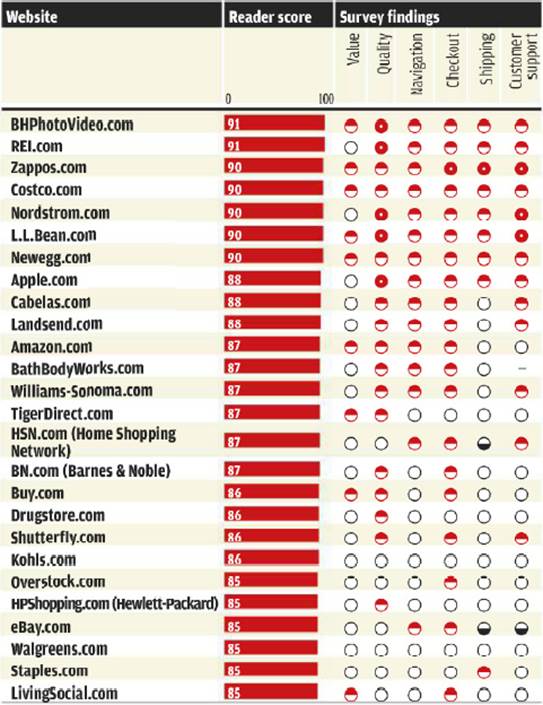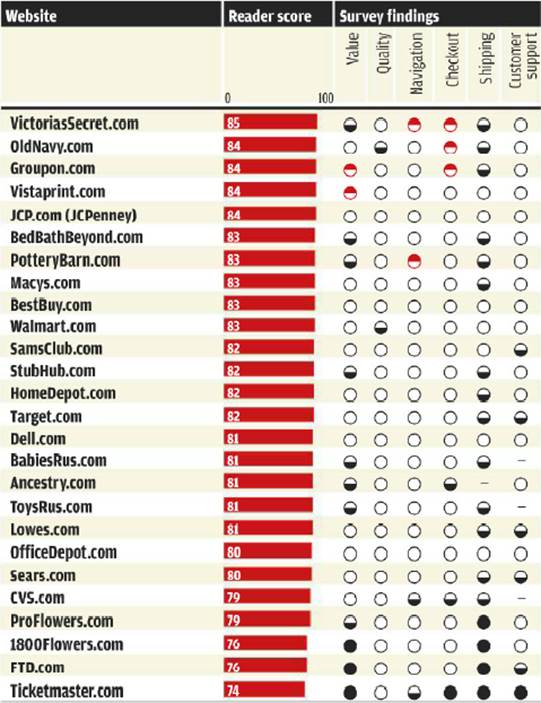Readers also told us about other website
attributes that make for a more-or less pleasant experience:
Search
function.
Search for “Converse” at Nordstrom and you
find 106 items with reviews. Pull-down menus at the top of the page let you
narrow the choices by color, price, brand, and store availability. Living
Social and Groupon, on the other hand, have no search function. At Groupon, to
find a deal we had seen earlier in the day, we had to resort to using Google.

Nordstrom
If you’ve narrowed your choice to a few
similar items, it’s handy being able to compare them side by side, as we did
with bicycles on REI, sweaters at L.L.Bean, and cameras at B&H Photo. On
Amazon or other sites without such a tool, open each product page in a separate
tab on your browser and compare that way.
B&H Photo and REI were among the
standouts.
User
feedback.
Sears and other sites display an overall
rating and the most helpful positive and negative reviews voted on by
customers. Many sites use a star system, with five for the top score.
Barbara Lawson, a reader from Colorado and
a professional photographer, said Amazon has “more people who write reviews, so
you get more information”. (As a rule, the more ratings and reviews, the
greater the chance of avoiding fraudulent reviews and getting an accurate idea
of a product or service.) Amazon’s product page also shows how the ratings are
distributed. For example, of the 687 customer ratings for a men’s electric
shaver 226 were five stars and 113 were one star. But Lawson says the reviews
on B&H Photo are usually more useful because the site is used by many
professional photographers. L.L.Bean and Sears let customers upload their own
video reviews, a nice touch.

Amazon
has “more people who write reviews, so you get more information”
At the other extreme, the deal site Living
Social has no user reviews or any other way for customers to provide feedback
that others can use. And Groupon take its review from other sites, such as
Frommer’s Travel Guides. TripAdviosr, and Yelp, and generally weeds out the
negative ones.

Frommer’s
Return
policy
Sites should have liberal return policies,
preferably beyond the 30-day limit you see from many retailers. And companies
should be willing to replace defective products within a reasonable period even
if the return policy has ended. (Of course, what’s reasonable depends on the
type of product. You wouldn’t expect a retailer with a 60-day return policy to
brush you off if a $2,000 refrigerator it sold you breaks down after 90 days,)
REI offers a 100 percent satisfaction
guarantee, letting shoppers return or replace items if they ever fail to meet
expectations. Zappos’ return policy also stands out: You have 365 days to send
back any item. (It pays for return shipping)

REI
offers a 100 percent satisfaction guarantee, letting shoppers return or replace
items if they ever fail to meet expectations.
Shop smart on any site
Here are other factors to consider when
shopping online, especially when buying from a retailer you haven’t tried
before:
Use a
separate email address.
To keep spam from reaching your regular
email account, use a different address for online purchases. Many internet
service providers let you set up numerous email accounts, which you can change
any time you want, or you can obtain a free account from such sites as Google.
If you don’t’ want to receive ads and promotions, make sure that the company
hasn’t’ automatically checked boxes in which you agree to receive such
materials.
See
products in person.
Check out big-ticket items at a local
retailer to see how they look and work in the real world. You can always buy
online if the walk-in store won’t match the best online price. If you buy
clothes online without trying them on in a store, make sure the site has a
liberal return policy. Factor in any return shipping charges.
Look
for gochas.
Read the site’s terms and conditions, FAQs,
and privacy policy. Find out what information will be collected, how long it
will be kept, and what will be done with it. If a site shares data, see whether
there’s a way to limit it. Make sure that any boxes that have you agreeing to
share aren’t checked by default. If you don’t’ understand something, ask, and
try to get the answers in writing, perhaps by using and saving an online chat
session with customer service.
See
what others say
Some sites, such as Amazon, let customers
rate retailers who sell through them. Do a Web search with the name of the site
and such terms as “review” and “complaints”. Read the entire company report (if
there is one) at the Better Business Bureau (bbb.org) and look for at least a
“B” rating.
Know
warranty limits.
When shopping online, you generally don’t’
get an “implied warranty of merchantability,” meaning the right to receive a
product that is free of defects and lasts a reasonable length of time. An
implied warranty can extend your protection beyond the product warranty and the
store’s return policy. Under state law, it automatically accompanies most
new-product sales unless the retailer “disclaims” it-rare for walk-in stores
but common for online sellers. Check the fine print. To preserve your basic
warranty rights when making a major purchase, consider shopping at a walk-in
store.
Use
credit.
Credit cards provide greater security than
debit cards, allowing you to obtain a chargeback if there’s a problem. Some
card issuers let you create temporary account numbers to use when shopping
online so that you don’t’ have to hand over your actual card number.

Credit
cards provide greater security than debit cards
Keep
records.
Once you buy something, expect the site to
email a summary of your order. Keep a copy of the order page-perhaps using a
screen shot-in case you don’t receive the email.
Ratings Online retailers in order of reader score.



Guide
to the Ratings
Ratings are based on 28,758 responses by
our subscribers to a survey conducted by the Consumer Reports National Research
Center. The survey reflects 52,437 website visits between April 2011 and July
2012. Findings represent the experiences of our readers, not necessarily those
of the general population. Reader score represents overall satisfaction with
the site and isn’t limited to the criteria listed under survey findings. A
score of 100 would mean all respondents were completely satisfied; 80 means
they were very satisfied, on average; 60, fairly satisfied. Differences of
fewer than 5 points are not meaningful. Scores for value, quality, navigation,
checkout, shipping, and customer support are relative. A dash indicates that we
lacked sufficient data.